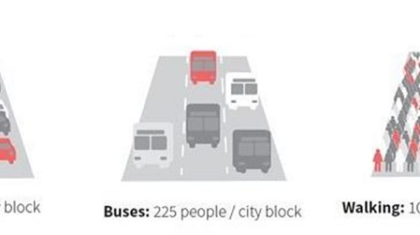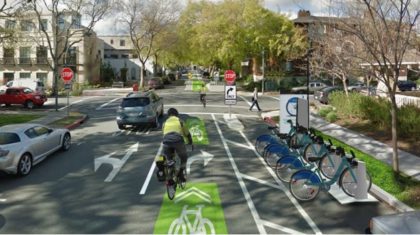
By Paul Wojciechowski, PE, AICP, LCI, Principal, Alta Planning + Design
So you installed low-stress bikeways…now what?
For communities across the country, installing low-stress bikeways such as bicycle boulevards or protected bike lanes can be a long, hard road. A ton of work leads up to reconfiguring a roadway. The process of building community and political support, developing conceptual and final engineering plans, securing project funding, overseeing construction crews, and finally getting the improvements on the ground can be a difficult journey.
But when the construction crew packs up, the ribbons are cut, and the bikeways are open to the public, the fun is really just beginning. For local agencies, the work on bikeways never truly ends. Education and outreach activities to support safe and responsible interactions along the new bikeways are key responsibilities of local agencies, as well as regular maintenance to keep the bikeways in good working order. This can include rides, events, and educational trainings to draw bicyclists to the new infrastructure. With a clear, direct strategy that has foresight into the typical problems that arise, local agencies can proactively make new bikeways a success with all roadway users in order to reach their full potential as valuable assets to the community.
While the actual planning of new bikeways is the main focus during project development and design, details of the education and outreach strategy after the project is implemented shouldn’t be overlooked. Having key stakeholders and knowledgeable community members still together to discuss options can lead to an understandable and consensus-driven outreach and education plan that maximizes the value of the community’s involvement.

Education
Low-stress bikeways are a relatively new and foreign concept for many communities across the United States. Protected bikeways and bicycle boulevards don’t always speak for themselves. Assuming everyone to know exactly how to drive or bike when they approach these facilities for the first time is dangerous. Even basic rules such as not driving in the bike lane and only crossing the bike lane to park or enter a driveway must be effectively communicated to the public. Educating bicyclists, motorists, transit operators, area residents, and all other community members is an important part of the implementation process. Public meetings, community-wide events, and various engagement activities are great opportunities for residents to learn about driving and biking along roads with these new low-stress bikeways. Stakeholder meetings, neighborhood association meetings, and pre-existing community festivals or events are also great opportunities to reach people, build support and share important educational information. Never underestimate printed materials — distributing door hangers, flyers, or postcards at nearby businesses and community centers can effectively bolster the project’s physical presence and foster understanding within the community. Social media and other online tools are also effective (and free!) ways to disseminate your message to a wide audience. By diversifying your strategy in several ways, you can reach a larger audience to more effectively educate the community.

Encouragement
Simply building new low-stress bikeways doesn’t mean that people will automatically utilize it. Local agencies and their local partners must do their part to draw people to new bikeways. Opportunities are limited only by local agencies’ own creativity. Many cities will incorporate the bikeway in established weekly bike rides or new special events, publicize with a ribbon-cutting ceremony, add bike parking to support the new bicycle traffic expected, or partner with local businesses to offer discounts to customers arriving on bike. If bicyclists aren’t aware of the benefits of the new bikeway, how can they be expected to get excited about it? By pairing effective education with strategic encouragement, local agencies can see to successful implementation of new bikeways.

Maintenance
Low-stress bikeways require regular upkeep, similar to any other street elements, in order to stay usable and beneficial to the public. Just as proper-functioning signage, lighting, and pavements markings are essential to the safety and operations of motor vehicles, as are bikeway elements for bike facilities for bicyclists. Pavement markings need to be clear and visible. Missing bollards need to be replaced. Bike lanes need regular sweeping. Before installing new low-stress bikeways, a jurisdiction should have a plan in place for the sweeping, snow removal, and routine maintenance of these facilities, since they are narrower than typical vehicle lanes and potentially require a different maintenance vehicle than the jurisdiction has in their fleet.
When new bike facilities are installed, the jurisdiction is committing to the maintenance and upkeep of this equipment. During the design stage, it is not enough just to identify new innovative bikeway types, great locations, and their capital costs, but additional questions should be considered, such as:
- What maintenance capabilities do you have?
- What kind of equipment is required to maintain the materials used?
- What is the lifespan of the materials being used?
- How often is routine maintenance required, and what is the cost?
- How will the maintenance be funded?
If you do not have the capability to maintain new facilities, you should have the financial capability to contract out the work. If not, the facilities could end in further disrepair and cause even more issue with funding repairs. Be sure to address these issues during the initial stages of the project with street maintenance staff to see that what is installed can be properly maintained.
While the process of planning and constructing new bikeways can feel like a huge feat, never lose sight of the road ahead after the project is on the ground. By educating and encouraging the community about the new bikeways, as well as having a realistic maintenance plan, local agencies can effectively make new bikeways a success within their community.


